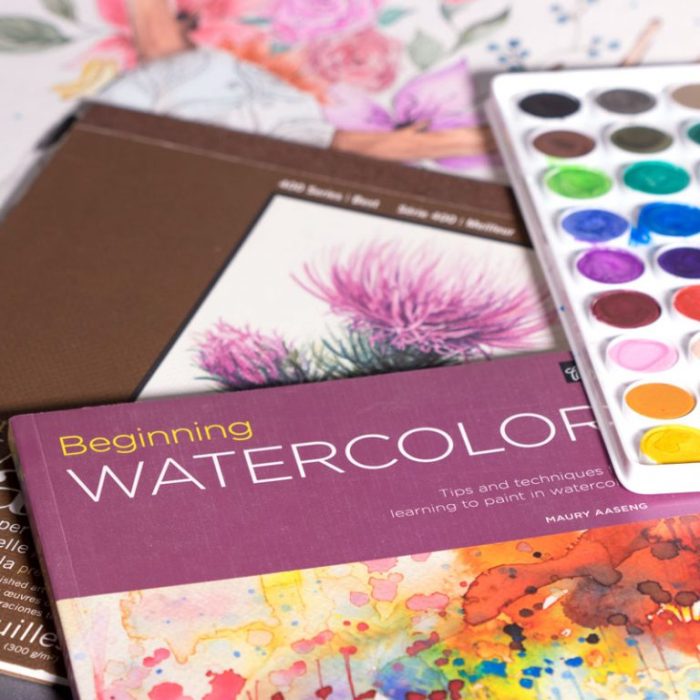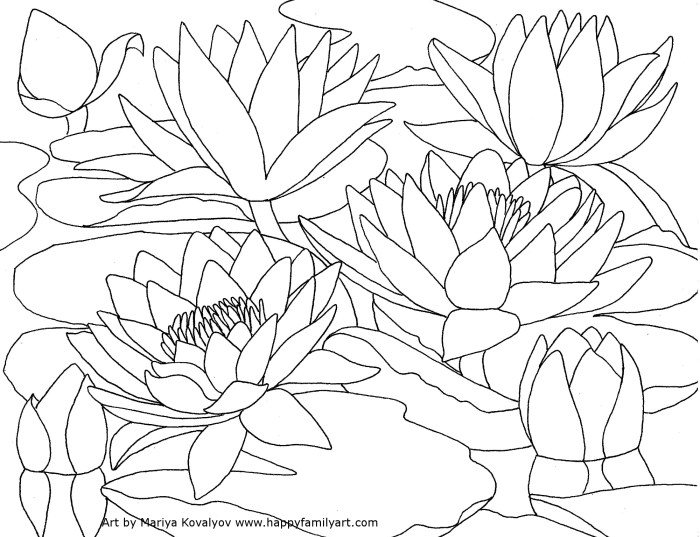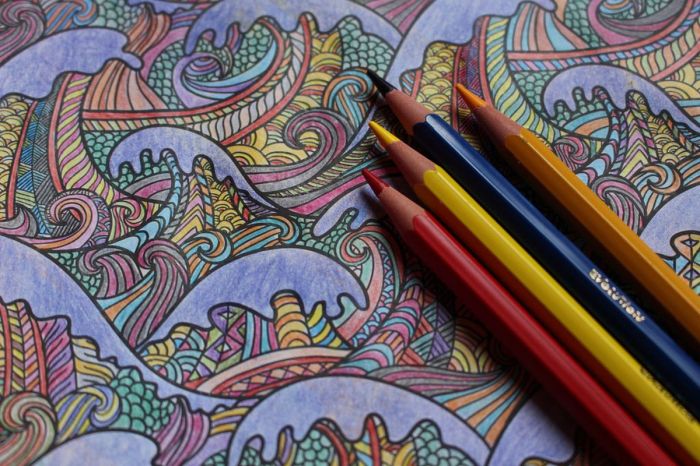Design & Artwork Considerations

Coloring book for watercolor – Creating a successful watercolor coloring book requires careful consideration of design and artwork. The layout, artistic style, color palettes, and the quality of the artwork itself all contribute significantly to the overall user experience and the book’s marketability. This section will detail key aspects to ensure a visually appealing and engaging coloring book.
Sample Page Layout
A well-designed page layout is crucial for a pleasant coloring experience. Too much space can feel wasteful, while overcrowding leads to frustration. The following table illustrates a sample two-column responsive layout, suitable for various page sizes. Margins are essential for preventing ink bleed and providing a clean, professional look.
| Column 1 | Column 2 |
|---|---|
|
This column would contain a larger, more detailed illustration. Consider leaving a generous 0.75-inch margin around the image to accommodate binding and prevent accidental coloring outside the lines. The image should be oriented to maximize the use of the space, taking into account the aspect ratio of the design. |
This column could feature smaller, complementary illustrations, perhaps related to the main image in Column 1. These could be simpler designs, allowing for a variety of coloring options and skill levels. Maintaining consistent margins is key here as well. |
Artistic Style and Theme Choices
The choice of artistic style and theme significantly impacts the book’s appeal. A cohesive theme helps create a unified and engaging experience. For example, a book themed around whimsical woodland creatures would benefit from a lighthearted, slightly cartoonish style, while a book focusing on botanical illustrations might employ a more realistic and detailed approach. The style should complement the chosen theme and target audience.
Color Palettes Suitable for Watercolor
Careful consideration of color palettes is crucial for a successful watercolor coloring book. The colors should be harmonious and encourage creative exploration. Here are some examples:
Several color palettes can enhance the watercolor experience:
- Earthy Tones: Warm browns, greens, oranges, and yellows create a natural and calming feel, ideal for landscapes or nature-themed designs.
- Cool Blues and Greens: These shades evoke a sense of serenity and are perfect for ocean scenes, floral designs, or fantasy landscapes.
- Vibrant Jewel Tones: Rich purples, deep blues, emeralds, and rubies add a touch of luxury and drama, suitable for more intricate and detailed designs.
- Pastel Palette: Soft pinks, lavenders, blues, and yellows create a delicate and romantic feel, suitable for whimsical or fairytale themes.
Artistic Styles for Watercolor Coloring Books
Three distinct artistic styles could be effectively employed:
- Botanical Illustration Style: This style focuses on precise rendering of plants and flowers, emphasizing detail and realism. Fine lines, delicate shading, and accurate representation of botanical structures are characteristic. Examples include detailed depictions of roses, ferns, or succulents, with a focus on accurate petal shapes, leaf venation, and overall plant form.
- Whimsical/Cartoon Style: This approach utilizes simplified forms, bold Artikels, and playful elements. It is characterized by exaggerated features, bright colors, and a focus on creating charming and engaging characters or objects. Think of cute animals, fantastical creatures, or quirky objects with expressive features.
- Zentangle-Inspired Style: This style incorporates repetitive patterns, intricate details, and flowing lines. It often features abstract designs with a focus on texture and visual interest. These designs can be meditative and relaxing to color, providing a sense of accomplishment as the intricate details are filled.
Creating High-Resolution Artwork, Coloring book for watercolor
High-resolution artwork is essential for ensuring sharp, clear prints in a coloring book. The artwork should be created at a resolution significantly higher than the final print resolution to avoid pixelation or loss of detail. For example, a 300 DPI (dots per inch) resolution is generally recommended for print. The process involves using professional-grade software like Adobe Illustrator or Photoshop to create vector or high-resolution raster images.
Careful attention to line weight and detail is crucial to ensure the lines are clear and easy to follow for the user, even after printing. The final artwork should be saved in a format suitable for printing, such as TIFF or high-quality JPEG.
Paper & Printing Specifications: Coloring Book For Watercolor

Choosing the right paper and printing method is crucial for a successful watercolor coloring book. The paper must be able to handle the wet-on-wet application of watercolors without buckling or feathering, while the printing process needs to reproduce the artwork with vibrancy and precision. The environmental impact of these choices should also be carefully considered.
Selecting appropriate paper and printing methods significantly influences the user experience and the overall quality of the watercolor coloring book. The right paper prevents color bleeding and ensures a smooth painting experience, while the printing process impacts color accuracy and detail. Environmental responsibility is also a critical aspect to consider throughout the production process.
Paper Types for Watercolor Painting
The choice of paper significantly impacts the watercolor painting experience. Different paper types offer varying levels of weight, texture, and absorbency, each influencing the final result. The following table compares key characteristics of suitable paper types:
| Paper Type | Weight (GSM) | Texture | Absorbency |
|---|---|---|---|
| Cold-pressed Watercolor Paper | 300-400 | Slightly textured | Moderate |
| Hot-pressed Watercolor Paper | 300-400 | Smooth | Low |
| Rough Watercolor Paper | 300-400 | Highly textured | High |
| Cardstock (suitable for lighter watercolor techniques) | 250-300 | Smooth to slightly textured | Low to moderate |
Printing Process Considerations
Achieving vibrant colors and fine detail in a watercolor coloring book requires careful consideration of the printing process. High-quality printing methods are essential for accurate color reproduction and sharp lines, enhancing the overall aesthetic appeal. Offset printing, with its ability to handle high volumes and produce consistent results, is often preferred. However, digital printing offers flexibility for smaller runs and potentially lower costs, especially for prototypes.
The choice will depend on the print run size and budget. Regardless of the method, color calibration and proofing are crucial to ensure the printed colors accurately reflect the original artwork.
Environmental Impact of Paper and Printing
The environmental impact of paper and printing should be a key consideration. Using recycled paper reduces deforestation and lowers overall environmental impact. FSC (Forest Stewardship Council) certified paper guarantees responsible forestry practices. Printing methods also vary in their environmental footprint; vegetable-based inks and processes that minimize waste are more sustainable options. Exploring options such as soy-based inks and eco-friendly printing processes can significantly reduce the carbon footprint.
Ideal Paper Stock Specifications
The ideal paper stock for a watercolor coloring book should balance performance and sustainability. A GSM (grams per square meter) of at least 300 is recommended to prevent buckling and feathering during watercolor application. Higher GSM values (e.g., 350 or 400) provide even better performance. A brightness level of around 90-95% ensures vibrant color reproduction. The paper should also be acid-free to ensure the longevity of the artwork and prevent yellowing over time.
Ideal Specifications: GSM 300-400, Brightness 90-95%, Acid-free, FSC certified.
Sustainable Packaging Solution
Sustainable packaging should align with the eco-conscious approach of using recycled paper. The packaging should be made from recycled cardboard or other easily recyclable materials. Minimizing packaging size and using minimal inks and adhesives further reduces environmental impact. Consider using printed inserts made from recycled paper instead of plastic sleeves. This approach reflects the commitment to environmental responsibility and enhances the product’s overall appeal to environmentally conscious consumers.
High-quality watercolor coloring books offer a delightful creative outlet, but can be expensive. Fortunately, if you’re looking for a cost-effective alternative, you can find many designs by exploring resources like free printable coloring books pdf websites. These often feature a variety of themes suitable for watercolor, allowing you to experiment with different styles and techniques before investing in a physical book.
This way you can test your watercolor skills and discover new artistic avenues.



